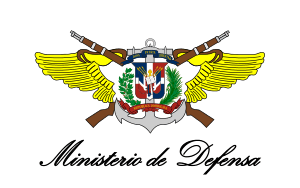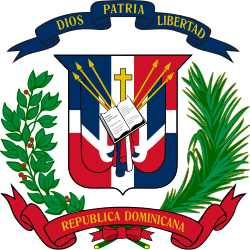Armed Forces of the Dominican Republic
| Dominican Armed Forces Fuerzas Armadas de la República Dominicana | |
|---|---|
 | |
| Service branches |
|
| Leadership | |
| Commander-in-Chief | President Danilo Medina |
| Minister of Defense |
Maximo Muñoz Delgado, Teniente General, ERD., (DEM) |
| Manpower | |
| Military age | 15 |
| Conscription | no |
| Available for military service | 2,239,309, age 15–49 |
| Fit for military service | 1,405,844, age 15–49 |
| Reaching military age annually | 86,569 |
| Active personnel | 24,500 (Ranked 94th) |
| Expenditures | |
| Percent of GDP | 1.1% (FY98) |
| Industry | |
| Foreign suppliers |
|
| Related articles | |
| History |
Dominican War of Independence Dominican Restoration War Second World War Dominican Civil War 2003 invasion of Iraq |
The Armed Forces of the Dominican Republic or Fuerzas Armadas de la República Dominicana consists of approximately 44,000 active duty personnel, approximately 60 percent of which are utilized mainly for non-military operations, including security providers for government-owned non-military facilities, toll security, forestry workers and other state enterprises, and personal security for ministers, congressmen, etc. The president is the commander in chief for the military. The primary missions are to defend the nation and protect the territorial integrity of the country. The Dominican Republic's military is second in size to Cuba's in the Caribbean.
The Army, twice as large as the other services combined with about 24,000 active duty personnel, consists of six infantry brigades, a combat support brigade, an air cavalry squadron and a combat service support brigade. The Air Force operates two main bases, one in southern region near Santo Domingo and one in the northern region of the country, the air force operates approximately 40 aircraft including helicopters. The Navy maintains three aging vessels which were donated from the United States, around 25 patrol crafts and interceptor boats and two helicopters.
There is a counter-terrorist group formed by members of the three branches. This group is highly trained in counter-terrorism missions. The armed forces participate fully in counter-illegal drug trade efforts, for this task there is a taskforce known as DEPROSER 24/7 (DEfender, PROteger y SERvir). They also are active in efforts to control contraband and illegal immigration from Haiti to the Dominican Republic and from the Dominican Republic to the United States (via illegal transportation of immigrants to Puerto Rico).
History
War of Independence
The military forces of the First Republic's army comprised about 4,000 soldiers organized into seven line infantry regiments, several loose battalions, 6 escudrones cavalry and 3 artillery brigades with 2/2 brigades; This army was supplemented with national civic guard militia composed of the provinces, the National Naval Armada, original name of the Navy today; It composed of 10 ships, seven owned and 3 taken in requición and armed by the government: the Cibao frigate with 20 cannons; the brigantine schooner San Jose, five guns; the schooner La Libertad, five guns; General schooner Santana 7 guns; the schooner La Merced, five guns; Separation schooner, 3 guns; the schooner February 27, five guns. The requisition taken: the schooner Maria Luisa, 3 guns; the schooner March 30, 3 guns; and the schooner Hope, 3 guns. 674 operated by a man. In addition to the aforementioned military corps expeditionary southern army recruited by Pedro and Ramon Santana in Hato Mayor and El Seibo, with a permit issued by the Central Governing Board with the rank of commander in chief of the army existed. These men were skilled in handling machete and spear. His deputy commander was Brigadier General Antonio Duvergé. The other expeditionary army was the Northern Borders created to defend these borders: its commander was Major General Francisco A. Salcedo.
Dominican forces come to reach a great level of organization and efficiency. The achievement and preservation of national independence, and the Dominican victory over the Haitians over repeated military invasions in the 12-year period that followed the proclamation; estimates place the military spending of the time at around 55 percent of the national budget.
20th century
The events that led to the United States military intervention of 1916, brought about the disappearance of any vestige of military structure in the Dominican Republic, setting the intervening forces a military government headed by Captain William Knapp, who make an interim police force called "Constabulary "equivalent to an" armed police force as a military unit "and he had the task of maintaining internal order and enforce the implementing provisions of the US government. This body, purely police function disappears in 1917, leading to the creation of a National Guard. As a result of this historic event of our recent past, the country inherited a hierarchical and organizational akin to the US Marine Corps structure, which served as a platform to the transformations that later gave rise to the armed forces we know today, made up of three components, terrestrial one, one and one naval air.
This land component, now called the National Army, inherited by both its organizational structure of the National Guard organized by the US occupation forces, which operated from April 7, 1917 until June 1921, when it becomes Dominican National Police by Executive Order No. 631 of Rear Admiral Thomas Snowden, who was at that time the military governor of Santo Domingo. After the US military occupation in 1924, Horacio Vásquez wins the presidential elections of that same year. Among his first decisions, decrees the change of the Dominican National Police in National Brigade, a situation that continues until 17 May 1928, when new turn changes the name of the Army by Law No. 928, but basically inheriting a structure Police, who obeyed schemes imposition of public order demanded by the country at that time and not those of an army in their typical roles.
Due to its characteristics and missions, organizational structure that demanded presence throughout the country, which was realized with the creation of posts and detachments in different parts of the country and the establishment in some provinces of company size units, many of which still Army retains today. Over the years and already existing National Police created by decree No. 1523 of March 2, 1936 of President Trujillo, many of these units, posts and detachments became part of it, perfectly adapted to its structure, since These were essentially created to play a policing role. So great was the influence that had the National Guard in Dominican society and very particularly in the rural population, which even today are many Dominicans who often referred to the Armed Forces and unique way to the Army as " The Guard ".
Meanwhile, the Navy has remained since its inception attached to the principles that gave rise, assuming only two name changes since its inception, but gradually evolving the transformation of what was a body created for military purposes, capable of landing and ships with weapons to face possible naval invasions, to be a component mainly responsible for enforcing the provisions on navigation, trade and fishing, as well as international treaties
The Dominican Air Force, meanwhile, emerges as an independent component in 1948, under the chairmanship of Generalissimo Rafael L. Trujillo Molina, with characteristics of innovation and modernism, which gave mobility, versatility and depth to the Armed Forces and the complement in the following years would become: a military capacity to project military power in the Caribbean environment. The situation of this air component has changed significantly after reaching its climax in the 50s, when it was one of the best air force equipped in the region, which was due to the strategic guidelines of a long-lived military dictatorship It made efforts to stay in power and he saw in this component one of its mainstays against any invasion or subversion against the dictatorship.
See also
- List of wars involving the Dominican Republic
- History of the Dominican Republic
- Dominican National Police
References
 This article incorporates public domain material from the CIA World Factbook document "2003 edition".
This article incorporates public domain material from the CIA World Factbook document "2003 edition".
